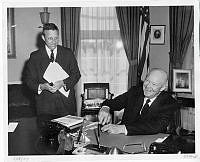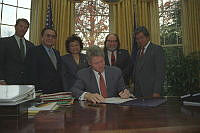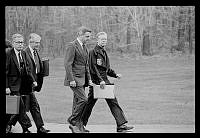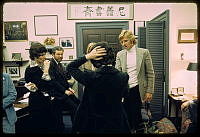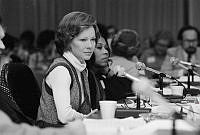Rubenstein Center Scholarship
John Tyler and Presidential Succession
Just after midnight on April 4, 1841, William Henry Harrison died after only thirty-one days in office. At daybreak on April 5th, Vice President John Tyler received a knock on his door in Williamsburg, Virginia, where he was visiting family. Fletcher Webster, the son of Secretary of State Daniel Webster, delivered the news of the president’s death. By dawn on April 6th, John Tyler had arrived in the nation’s capital.1

This 1888 engraving depicts a messenger delivering the news of President William Henry Harrison's death to Vice President John Tyler at his Williamsburg home on April 5, 1841.
Library of CongressOnce Vice President John Tyler arrived in Washington, D.C., the real questions began. In the twenty-first century, the line of presidential succession is clear – Tyler should have assumed the presidency and nominated a new vice president. In 1841 though, that precedent had yet to be established. William Henry Harrison was the first president to die in office, so there were no guidelines for how to proceed. The Constitution specified that:
“In case of the removal of the President from office, or of his death, resignation, or inability to discharge the powers and duties of the said office, the same shall devolve on the Vice President, and the Congress may by law provide for the case of removal, death, resignation or inability, both of the President and Vice President, declaring what officer shall then act as President, and such officer shall act accordingly, until the disability be removed, or a President shall be elected.”2
But questions remained. Should Tyler assume the presidency for the rest of Harrison’s term, or only until a new election could be held? Did he become president himself, or did he retain the title of Vice President or Acting President and merely assume presidential powers? The Constitution left those details open to interpretation.

This engraving shows the United States Marine Band preparing to play for the funeral procession of President William Henry Harrison on April 7, 1841. The White House is depicted in the background.
Kiplinger Washington CollectionJohn Tyler chose to quickly and definitively assert his role as the new President of the United States. On the day he arrived in Washington, he met with Harrison’s cabinet and invited them all to stay on under his leadership. Although he believed that his vice-presidential oath qualified him to perform the duties of the office, he took a new presidential oath in the presence of his cabinet to bolster his claim.3 Every vice president to ascend to the presidency since Tyler has followed his example. Three days later, he issued an inaugural address in which he described himself as “called to the high office of President” by God.4 As the final step in solidifying his claim to the presidency, Tyler moved himself and his family into the White House within a week of Harrison’s funeral, when the state rooms were still hung with black mourning crape.5
Many of President Tyler’s political opponents felt that he overreached his position and that he should retain the title of “Acting President.” On April 16, Massachusetts congressman and former president John Quincy Adams wrote that Tyler “styles himself President of the United States, and not Vice-President acting as President, which would be the correct style.”6 Adams and others gave Tyler the nickname “His Accidency.”7 By June 1, both houses of Congress easily passed resolutions affirming Tyler’s status as president, which should have put the matter to rest. However, opponents continued to use the title “Acting President” for the next four years. It appeared in newspapers that were critical of Tyler’s policies and on letters sent by political adversaries.8 President Tyler returned mail that refused to address him by his proper title unopened.9

While the 1841 resolution to affirm John Tyler's status as president easily passed, it was not without its critics. Democrat John McKeon of New York made this motion to alter the text of the resolution, replacing the word "President" with "Vice President now exercising the office of President of the United States." The motion ultimately failed.
National Archives and Records AdministrationUltimately, Tyler’s unprecedented ascension to the presidency created political divisions that left him without a party. He had been elected as a member of a Whig ticket but refused to adhere to the party orthodoxy when he became president, rejecting the plan for a national bank that had been central to the Whig platform. The party had planned for a Harrison, not a Tyler presidency, and had no idea how to handle this turn of events. By 1844, Tyler had been rejected by both the Whigs and the Democrats. He ran for re-election as a third-party candidate but trailed so far behind that he ultimately withdrew from the race and threw his support behind Democratic candidate James K. Polk, helping Polk to become the eleventh president of the United States.10
Although Tyler’s presidency itself was hampered by partisan conflict, his ascension to the office set an important precedent. Less than a decade later, when President Zachary Taylor died in office, Vice President Millard Fillmore succeeded him with little controversy or conflict. In total, nine vice presidents have taken over the highest office after the death or resignation of a president, and Tyler set the precedent for them to follow.11 Had he approached the situation differently, we might have a system of acting presidencies and special elections today, rather than a smooth transfer of presidential power.

George Peter Alexander Healy's 1859 portrait of President John Tyler.
White House Historical Association/White House CollectionWhile Tyler became president in 1841, he did not appoint a vice president. The Constitution did not provide a mechanism for replacing a vice president who had died, resigned, or become president. Until 1967, vacancies in the vice presidency were left open until the next election. From 1789 to 1967, sixteen different vacancies occurred, spanning a total of over thirty-seven years. In 1967, following the assassination of President John F. Kennedy, the states ratified the 25th Amendment, which formally clarified the process of presidential succession. The amendment allowed the president to nominate a new vice president if that office became vacant. It also institutionalized the precedent Tyler had established 126 years earlier: “In case of the removal of the President from office or of his death or resignation, the Vice President shall become President.”12














